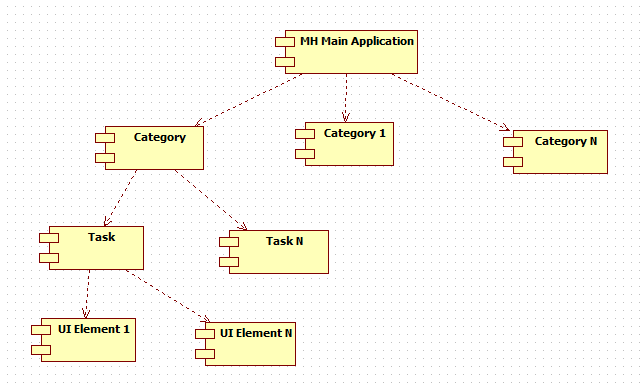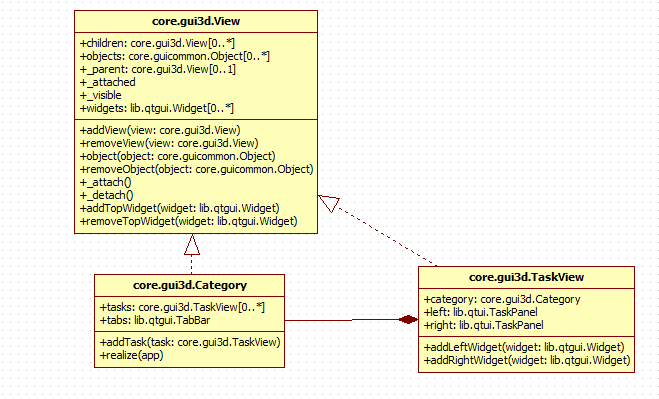The Gui3D Module¶
Category,TaskView¶
In MH, an artist can perform various operations on a humanoid.Broadly we can divide these operations in groups as follows: Modelling - for physical modifications in humanoid Geometries - for additional aspects like hair,teeth etc Materials - for materials selection Pose/animate - for rigging etc Rendering
In MH,these groups are termed as categories. And activities grouped under a category are called as tasks. So each task represents a specific activity. Like,gender is a task under Modelling category which allows user to make gender specific modelling. MH is organized with main application at top and categories under it, and tasks arranged under each category. For each task, various widget elements are provided for user interaction.These include GUI elements like sliders, buttons,check boxes etc. We can visualise MH as a tree structure with main application sitting at top, categories under it, tasks under respective category and UI elements stacked inside a task.

MakeHuman component architecture
At code level, a task and a category is classified as a View(core.gui3d.View). A view can be looked upon as a container for other MH elements. So a category is a view as it contains tasks, while a task is also a view as it contains UI elements.

MakeHuman view hierarchy
Every view has following attributes:
class View(events3d.EventHandler):
def __init__(self):
self.children = [] self.objects = [] self._visible = False self._totalVisibility = False self._parent = None self._attached = False self.widgets = []
children are the views a view contains. objects are 3D rendering objects will be rendered in the opengl canvas visible is a flag to keep track of visibility of view parent is the MH element this view belongs to widgets are the associated UI elements _totalVisibility is an implementation detail hidden from the public interface. It’s used to determine the isVisible() status. A View with a parent is only visible if its own visibility flag is true, and its parents are visible as well.
When a view is attached, then all of its children and objects are also attached, and same holds true when it is detached.
- def _attach(self):
self._attached = True
- for object in self.objects:
- object._attach()
- for child in self.children:
- child._attach()
- def _detach(self):
self._attached = False
- for object in self.objects:
- object._detach()
- for child in self.children:
- child._detach()
When a view is added,if this view is attached to the app, the view will also be attached.
- def addView(self, view):
- if view.parent:
- raise RuntimeError(‘The view is already added to a view’)
view._parent = weakref.ref(self) view._updateVisibility() if self._attached:
view._attach()self.children.append(view)
return view
Similarly,while removing a view from this view,if this view is attached to the app, the view will be detached. Just like for view, add/remove functions are also available for member objects, and have behaviour in terms of attachment/detachment. When an object id added to this view,if the view is attached to the app, the object will also be attached and will get an OpenGL counterpart. While removing the object from the view,if the object was attached to the app, its OpenGL counterpart will be removed as well.
A view can also have widgets associated to it. So there is a list for holding widgets,self.widgets.Methods are provided to add/remove widget to/from a view, which are addTopWidget/removeTopWidget. These methods also call function to add widget to the main window(lib.qtui.Frame) of the application.
View class also has many event handling functions like onShow,onHide and various mouse related events.
In MH, as discussed above we have concept of Task which basically represents a very specific activity domain in MH concerns.Like we have ‘Face’ task under ‘Modelling’.At code level, a task is represented by TaskView(core.gui3d.TaskView). A TaskView inherits from View. In addition it has several more attributes.
class TaskView(View):
- def __init__(self, category, name, label=None):
- super(TaskView, self).__init__() self.name = name self.category = category self.label = label self.focusWidget = None self.tab = None self.left, self.right = mh.addPanels() self.sortOrder = None
name is taskview’s name category is the category to which this taskview belongs tab is the instance of lib.qtgui.Tab, refering to tab in parent category to which this task is assigned left and right are the panels(lib.qtui.TaskPanel) for the taskview which are added to main window(lib.qtui.Frame).TaskPanel inherits from lib.qtgui.VScrollArea, which in turn contains a scroll bar(QtGui.QScrollBar). Any widget we want to have for a taskview,we add to these panels.
- def addLeftWidget(self, widget):
- return self.left.addWidget(widget)
- def addRightWidget(self, widget):
- return self.right.addWidget(widget)
Similarly, we also have functions to remove widgets from a taskview.
In MH, a category is a group of domain specific tasks.Like Modelling is is a category with various tasks under it. At code level, a category is represented by core.gui3d.Category and it also inherits from View just like TaskView.
class Category(View):
- def __init__(self, name, label = None):
- super(Category, self).__init__() self.name = name self.label = label self.tasks = [] self.tasksByName = {} self.tab = None self.tabs = None self.panel = None self.task = None self.sortOrder = None
tabs(lib.qtgui.TabBar) is for adding tabs, with each tab assigned to a member task present in self.tasks tasks is the list of associated taskviews task is the name of the current task. Category has function addTask() to add task to it. Another important function is realize(), which adds all member tasks to tab bar.
Project Name: MakeHuman
Product Home Page: http://www.makehuman.org/
Code Home Page: https://bitbucket.org/MakeHuman/makehuman/
Authors: Manuel Bastioni, Marc Flerackers
Copyright(c): MakeHuman Team 2001-2015
Licensing: AGPL3 (http://www.makehuman.org/doc/node/the_makehuman_application.html)
This file is part of MakeHuman (www.makehuman.org).
This program is free software: you can redistribute it and/or modify it under the terms of the GNU Affero General Public License as published by the Free Software Foundation, either version 3 of the License, or (at your option) any later version.
This program is distributed in the hope that it will be useful, but WITHOUT ANY WARRANTY; without even the implied warranty of MERCHANTABILITY or FITNESS FOR A PARTICULAR PURPOSE. See the GNU Affero General Public License for more details.
You should have received a copy of the GNU Affero General Public License along with this program. If not, see <http://www.gnu.org/licenses/>.
Coding Standards: See http://www.makehuman.org/node/165
Abstract¶
This module contains classes defined to implement widgets that provide utility functions to the graphical user interface.
Importing this module loads OpenGL dependencies.
- class gui3d.Application[source]¶
The Application.
- addObject(object)[source]¶
Adds the object to the application. The object will also be attached and will get an OpenGL counterpart.
Parameters: object (gui3d.Object) – The object to be added. Returns: The object, for convenience. Rvalue : gui3d.Object
- addView(view)[source]¶
Adds the view to the application.The view will also be attached.
Parameters: view (gui3d.View) – The view to be added. Returns: The view, for convenience. Rvalue : gui3d.View
- getTask(category, task)[source]¶
Retrieve a task by category and name. Will not create a task or category if it does not exist.
Set category to None or False to search for a task by name. Will raise an exception when the result is ambiguous (there are multiple tasks with the same name in different categories). This quickhand is mostly useful for shell usage, but dangerous to use in a plugin.
- removeObject(object)[source]¶
Removes the object from the application. Its OpenGL counterpart will be removed as well.
Parameters: object (gui3d.Object) – The object to be removed.
- removeView(view)[source]¶
Removes the view from the application. The view will be detached.
Parameters: view (gui3d.View) – The view to be removed.
- class gui3d.View[source]¶
The base view from which all widgets are derived.
- addObject(object)[source]¶
Adds the object to the view. If the view is attached to the app, the object will also be attached and will get an OpenGL counterpart.
Parameters: object (gui3d.Object) – The object to be added. Returns: The object, for convenience. Rvalue : gui3d.Object
- addView(view)[source]¶
Adds the view to this view. If this view is attached to the app, the view will also be attached.
Parameters: view (gui3d.View) – The view to be added. Returns: The view, for convenience. Rvalue : gui3d.View
- removeObject(object)[source]¶
Removes the object from the view. If the object was attached to the app, its OpenGL counterpart will be removed as well.
Parameters: object (gui3d.Object) – The object to be removed.
- removeView(view)[source]¶
Removes the view from this view. If this view is attached to the app, the view will be detached.
Parameters: view (gui3d.View) – The view to be removed.